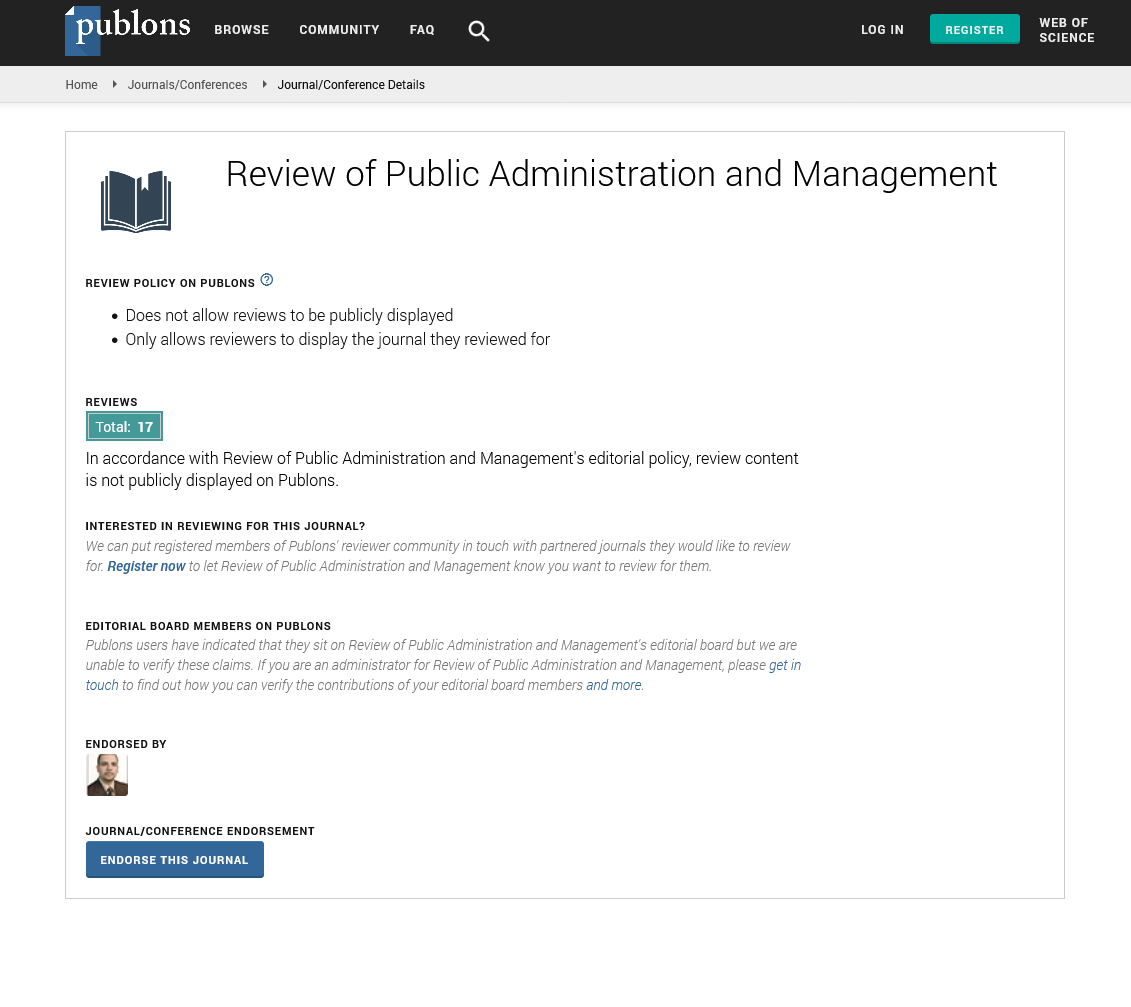Indexed In
- CiteFactor
- RefSeek
- Directory of Research Journal Indexing (DRJI)
- Hamdard University
- EBSCO A-Z
- Scholarsteer
- Publons
- Euro Pub
- Google Scholar
Useful Links
Share This Page
Journal Flyer

Open Access Journals
- Agri and Aquaculture
- Biochemistry
- Bioinformatics & Systems Biology
- Business & Management
- Chemistry
- Clinical Sciences
- Engineering
- Food & Nutrition
- General Science
- Genetics & Molecular Biology
- Immunology & Microbiology
- Medical Sciences
- Neuroscience & Psychology
- Nursing & Health Care
- Pharmaceutical Sciences
Commentary - (2025) Volume 13, Issue 2
Comparative Insights into Local Government Efficiency
Hana Sato*Received: 02-Jun-2025, Manuscript No. RPAM-25-29752; Editor assigned: 04-Jun-2025, Pre QC No. RPAM-25-29752; Reviewed: 17-Jun-2025, QC No. RPAM-25-29752; Revised: 21-Jun-2025, Manuscript No. RPAM-25-29752; Published: 28-Jun-2025, DOI: 10.35248/2315-7844.25.13.488
Description
Local governments operate at the intersection of citizens daily lives and national policies. Their efficiency directly influences how communities perceive the quality of governance and how resources are utilized to promote social and economic development. Efficiency in this context goes beyond financial cost-cutting. It encompasses timeliness of service delivery, fairness in decision-making, adaptability to emerging needs and the ability to achieve desired outcomes with available resources. Examining comparative experiences across countries provides valuable insights into what makes local administrations effective and how efficiency can be improved in different contexts. In Japan, local government efficiency has been a priority for decades. Municipalities have increasingly adopted digital platforms to handle routine administrative tasks such as issuing certificates, processing tax forms and updating residency records. These initiatives significantly reduce paper-based processes and minimize long queues at government offices. The time saved allows public officials to redirect their attention toward community programs such as elder care or disaster preparedness. Japan’s experience illustrates how investments in digital infrastructure can improve efficiency without undermining service quality. However, the benefits of digitalization are unevenly distributed. Smaller municipalities with limited budgets sometimes struggle to keep up, creating disparities within the country itself.
Germany provides another interesting perspective. German local governments emphasize integration between administration and regional development projects. For example, local councils often coordinate with private stakeholders to design infrastructure, educational facilities and cultural programs. Efficiency here is not measured solely by financial indicators but also by the longterm developmental benefits generated by administrative actions. This approach reflects a philosophy that public administration should not merely manage existing services but actively contribute to local growth. By embedding efficiency within broader developmental goals, German local governments ensure that resources are allocated strategically rather than narrowly focused on short-term savings. One common feature of highperforming local governments worldwide is the systematic use of performance indicators. These indicators track not only service delivery outputs, such as the number of permits issued, but also outcomes, such as citizen satisfaction and community well-being. For example, municipalities may record how long it takes to process housing permits or to respond to complaints about road maintenance. Over time these indicators provide benchmarks for assessing progress. In Japan, the introduction of measurable targets for administrative tasks has encouraged a culture of continuous improvement, as local officials can identify bottlenecks and adjust processes accordingly.
Yet efficiency is not merely a technical matter; it is deeply influenced by the human element. Skilled administrators play a decisive role in ensuring that reforms and innovations translate into real outcomes. Training programs that focus on negotiation, conflict resolution and problem-solving have enabled local officials to respond effectively to unexpected demands. For instance, during natural disasters in Japan, local administrators who had received crisis management training were able to coordinate emergency shelters, supplies and rescue operations swiftly. This demonstrates that human capacity is as important as technological investment in achieving efficiency. Comparative insights also highlight the challenges that accompany efficiencyoriented reforms. In some cases, overemphasis on cost reduction can lead to unintended consequences. For instance, excessive budget cuts in local health services may reduce expenditures in the short run but can produce long-term social costs such as rising illness rates or declining community trust in government. Similarly, outsourcing administrative functions to private firms can sometimes reduce expenses but may also compromise accountability if oversight is weak. Therefore, efficiency must be pursued in balance with equity and quality.
Brazil’s experience with participatory budgeting offers another dimension of efficiency. Citizens are directly involved in deciding how portions of the municipal budget should be allocated. Although this process may initially appear timeconsuming, it enhances efficiency in the broader sense by ensuring that resources are directed toward projects that reflect real community needs. When residents feel ownership of public initiatives, they are more likely to support and maintain them, reducing waste and improving outcomes. Participation also reduces the risk of misallocation by aligning administrative actions with grassroots priorities. Technology continues to transform how efficiency is understood and measured. Online portals, mobile applications and open data platforms allow citizens to access information, request services and monitor government actions with ease. In countries such as Switzerland and the United Kingdom, these platforms have shortened response times for basic services and improved public perceptions of administrative responsiveness. However, digitalization also raises questions about inclusiveness. Citizens without reliable internet access or digital literacy risk being excluded from the benefits of such reforms. Efficiency, therefore, must be evaluated not only by speed or cost but also by accessibility.
Ultimately, efficiency in local government cannot be divorced from the broader political and cultural context. In societies where trust in public institutions is high, efficiency reforms may be more readily accepted and implemented. In contrast, in settings where corruption or political interference is widespread, even well-designed reforms may fail to deliver. Comparative studies reveal that efficiency is less about adopting a single model and more about adapting principles to local circumstances. In conclusion, efficiency in local governments is a multidimensional concept that goes beyond financial savings. It involves timely and fair service delivery, alignment with developmental goals, skillful human resources and inclusive use of technology. Japan’s digital reforms, Germany’s integration of development with administration and Brazil’s participatory budgeting all illustrate diverse approaches to enhancing efficiency. The comparative perspective underscores that there is no one-size-fits-all solution. Efficiency must be understood as a dynamic process shaped by context, culture and citizen expectations. Local governments that recognize this complexity are more likely to deliver meaningful improvements in the lives of their communities.
Citation: Sato H (2025). Comparative Insights into Local Government Efficiency. 13:488.
Copyright: © 2025 Sato H. This is an open-access article distributed under the terms of the Creative Commons Attribution License, which permits unrestricted use, distribution and reproduction in any medium, provided the original author and source are credited.


